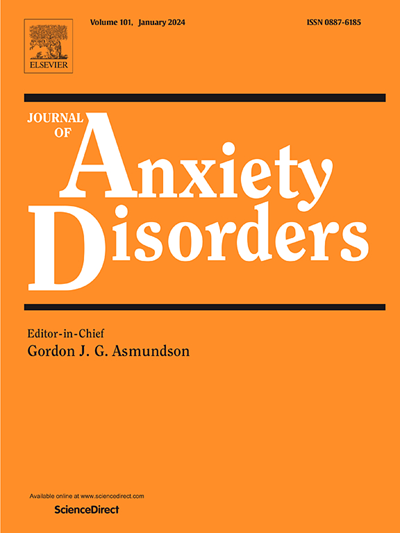找到你的节奏和调节:呼吸同步振动反馈在呼吸集中正念减少呼吸变异性创伤暴露的成年人
IF 4.5
2区 医学
Q1 PSYCHIATRY
引用次数: 0
摘要
压力和焦虑与包括呼吸改变在内的自律神经唤醒增加有关。以呼吸为重点的正念冥想可以减轻压力和焦虑,但受到创伤的成人解离症患者很难参与这种练习。我们正在进行的临床试验将研究振动增强呼吸正念冥想(VABF)能否改善疗效并提高参与度。在此,我们测试了 VABF 是否会降低呼吸频率(RR)或呼吸变异性(RV),并研究了 RR、RV 和情绪评级之间的关联。128名受到创伤的成年人(平均年龄=30.21岁)自愿参加并完成了至少50%的干预访问。参与者被随机分配到四种正念冥想干预中的一种:VABF (n = 34);仅呼吸聚焦 (n = 33);仅振动 (n = 34);开放意识(无振动或呼吸聚焦,n = 27)。线性混合效应模型的结果表明,VABF 降低了各次就诊的 RV,而所有其他干预措施都提高了各次就诊的 RV(P = .008;ηP2 = .014),RV 与焦虑和愤怒评分呈正相关(PS < .001;RS > .125)。研究结果表明,在自律神经唤醒和负性情绪升高的临床人群中,RV 是一种有意义的调节过程指标。研究还表明,RV 可通过 VABF 进行调节,这为改善创伤暴露人群的调节过程提供了重要的干预手段。本文章由计算机程序翻译,如有差异,请以英文原文为准。
Find your rhythm and regulate: Breath-synced vibration feedback during breath-focused mindfulness reduces respiration variability in trauma-exposed adults
Stress and anxiety are associated with increased autonomic arousal, including altered respiration. Breath-focused mindfulness meditation can reduce stress and anxiety, but trauma-exposed adults with dissociation have difficulty engaging in this practice. Our ongoing clinical trial examines if vibration-augmented breath-focused mindfulness (VABF) can improve outcomes and increase engagement. Here, we tested if VABF reduces respiration rate (RR) or respiration variability (RV), and examined associations between RR, RV, and emotion ratings. 128 trauma-exposed adults (mean age = 30.21 years) with elevated dissociation volunteered and completed at least 50 % of intervention visits. Participants were randomized to one of four mindfulness meditation interventions: VABF (n = 34); breath-focus only (n = 33); vibration only (n = 34); open awareness (no vibration or breath-focus, n = 27). Results from linear mixed-effects models showed that VABF decreased RV across visits while all the other interventions showed increased RV across visits (p = .008; ηp2 = .014), and RV was positively associated with both anxiety and anger ratings (ps < .001; rs > .125). Findings suggest RV is a meaningful metric for examining regulatory processes in clinical populations with elevated autonomic arousal and negative emotionality. They also show that RV is modifiable through VABF, which holds significant promise as an intervention to improve regulatory processes in trauma-exposed populations.
求助全文
通过发布文献求助,成功后即可免费获取论文全文。
去求助
来源期刊

Journal of Anxiety Disorders
Multiple-
CiteScore
16.60
自引率
2.90%
发文量
95
期刊介绍:
The Journal of Anxiety Disorders is an interdisciplinary journal that publishes research papers on all aspects of anxiety disorders for individuals of all age groups, including children, adolescents, adults, and the elderly. Manuscripts that focus on disorders previously classified as anxiety disorders such as obsessive-compulsive disorder and posttraumatic stress disorder, as well as the new category of illness anxiety disorder, are also within the scope of the journal. The research areas of focus include traditional, behavioral, cognitive, and biological assessment; diagnosis and classification; psychosocial and psychopharmacological treatment; genetics; epidemiology; and prevention. The journal welcomes theoretical and review articles that significantly contribute to current knowledge in the field. It is abstracted and indexed in various databases such as Elsevier, BIOBASE, PubMed/Medline, PsycINFO, BIOSIS Citation Index, BRS Data, Current Contents - Social & Behavioral Sciences, Pascal Francis, Scopus, and Google Scholar.
 求助内容:
求助内容: 应助结果提醒方式:
应助结果提醒方式:


